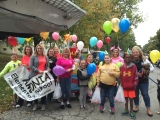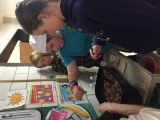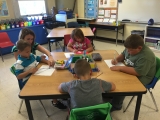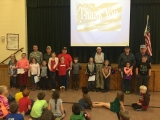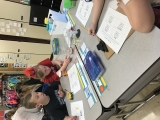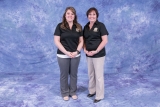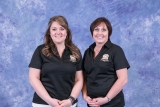-
Category 2
Selected in 2016
-
Grades: k - 5
School Setting: rural
Town Population: 312
Student Enrollment: 95
Student Demographics:
Black/African American: 5%
Teacher/Student Ratio: 1:15
White/Caucasian: 93%
Hispanic: 2%
Hawaiian/Pacific Islander: 0%
Asian: 0%
Native American: 0%
Other: 0%
% Reduced Lunch: 54%
% ELL Learners: 2%
Founded: 1958 -
PRINCIPAL:
Aimee Addington -
CONTACT:
845 6th Street
Amazonia, MO 64421
816-475-2161
aaddington@savannahr3.com
Amazonia Elementary
Amazonia, MO
Amazonia Elementary provides students a safe, nurturing environment where they feel comfortable and are willing to be risk-takers.
- Describe specific programs in place to ensure that families are involved in the success of your school and students.
-
Amazonia Elementary encourages families to be involved in student and school success. Our Open House, Back to School Night, Monthly Family Nights, Kids in the Kitchen, KinderClub, and Community Garden encourage parent and community involvement as well. Our school-wide talent show strengthens students’ confidence and self-esteem while showcasing their special talents and gifts.
Communication provides a foundation for community involvement in our school. Student planners provide daily communication between teachers and families. Social media entices parents to view school activities, photos, and reminders of upcoming events. Families monitor student progress in our student information system, which allows them access to student grades electronically. Newsletters, PTO, positive phone calls, text messages, emails, quarterly awards assemblies, and parent-teacher conferences also allow families to be involved in our school and help celebrate our accomplishments at Amazonia. - Describe the most successful activity your school has initiated to strengthen ties to your community.
-
Amazonia Elementary has worked hard to create a strong climate and culture in our school community in a variety of ways. Communication is essential to strengthen our ties between the school, families and community to help keep everyone informed and welcomed.
Monthly Family Nights have proven to be an excellent way for families and community members to participate in fun, educational activities where students are excited to work with their family, friends, and staff in a relaxed school setting.
As part of a partnership and grant provided by Mosaic Health Care, Amazonia Elementary School has created a community garden. Students are engaged in all stages of the community garden from planning, planting to harvesting. Students have ownership in the garden and have helped provide our community with an abundance of produce. During the past two years, we have been able to donate to our families, a local church, and our area food kitchen. - Describe your philosophy of school change or improvement.
- All students can learn is the philosophy of Amazonia Elementary. Students learn at different paces and have different learning styles. As educators, we must frequently monitor student progress and learning. We must provide students with the tools they need to succeed. Amazonia Elementary provides our students a safe, nurturing environment where they feel comfortable and are willing to be risk-takers.
- What are your school’s top two goals for the next year?
- Amazonia Elementary’s top two goals for the next year focus on our continued efforts to improve student learning through the Professional Learning Community (PLC) process and data cycles. Next year, our district will focus on “best practices” and instructional tools for classroom teachers. Active student engagement and integration of technology in classroom instruction and learning remain a continued focus in our school and district.
- What is the single most important factor in the success of your school that others could replicate?
-
A positive school climate and culture at Amazonia Elementary is the foundation for our success. We love and care for each individual student. Students are cared for as individual people, not just another number or another student. Our school is a large family in which we know each child and their families on a personal level.
There is no "one size fits all" way of educating students. Students require different learning environments and techniques. Our number one priority is our students – the whole child. Our student priority and focus requires team effort by all. Everyone has a voice, and their voice is valued. We encourage each other, support each other, and collaborate.
Our success can be contributed to a strong, positive school climate and culture which encompasses: genuine interest in students, trusting and supportive relationships, a belief that all students can and will learn, educating the whole child, and ensuring that students are impassioned and empowered. - Describe the program or initiative that has had the greatest positive effect on student achievement, including closing achievement or opportunity gaps, if applicable.
- Amazonia Elementary’s focus on data has had the greatest impact on student achievement. Data team meetings, data notebooks, RtI, staff and student goals are an integral part of our learning environment. Data is collected and analyzed, allowing staff to differentiate instruction in order to meet the needs of all students. Data driven student education plans are developed and implemented during RtI and tutoring. Through the analysis of data, teachers are able to reflect upon instructional strategies and how to improve student achievement based upon specific skills and standards. Kagan strategies are used to enhance differentiated instruction and student engagement.
- Explain how Title I funds are used to support your improvement efforts.
- Title I funds support academic improvement efforts by providing the salaries of Title 1 teachers, as well as our guidance counselor. Research-based interventions have been purchased to assist us in meeting the individual needs of students as well as closing the achievement gap for at risk students. We have also used these funds to provide individual or small group tutoring for students in the areas of math and reading. Title 1 funds also supplement our monthly Family Nights.
- Identify the critical professional development activities you use to improve teaching and student learning.
-
Amazonia’s professional development focus has been on data which increased student achievement and accountability. Our staff has received professional development in analyzing student data, developing effective data cycles, and developing SMART goals for staff and students. Kagan professional development was also provided to our staff to promote active student engagement and learning. We have developed building level DMRs (Decision- Making for Results) focusing on fluency, student engagement, and the skill of compare and contrast.
Professional development and training on how to use student data notebooks, Renaissance Learning products, and Mastery Connect allow teachers and students immediate feedback on student progress to assist in conferencing, goal setting, and development of student education plans. The emphasis on data and how to use data effectively have been critical components to improve teaching and student learning at Amazonia Elementary. - Describe how data is used to improve student achievement and inform decision making.
-
Data team meetings focus on ALL students on a spectrum from struggling learners to strong learners. We use our data to create student-specific groups, skills groups and data cycles which focus on essential standards to develop educational plans for each individual student. Teachers utilize data to differentiate instruction. As teachers conference with students, the students set individual goals to build on their strengths and skills to develop further.
We have utilized a variety of tools to collect data. Presently, we are using the following: STAR Reading, STAR Math, STAR Early Literacy, Accelerated Reading, Compass Learning, running records, Response to Intervention groups, Mastery Connect, and data notebooks. STAR data is analyzed to set RTI groups, discuss educational plans, and analyze each student’s progress. Data determines Response to Intervention placement, literature groups, and areas of concern to guide differentiated instruction. - Describe your school culture and explain changes you’ve taken to improve it.
- Amazonia Elementary School has a family-like atmosphere. As a smaller school, everyone knows and cares for one another, while also embracing each other’s individual uniqueness. We educate and develop ways to recognize and respect each other’s differences and abilities. We create an environment that exudes team, change, growth, and instills positivity for our community through team building activities, PLC training, and book studies. We focus on the whole child from their current home life to their future success!
Stats
-
Category 2
Selected in 2016
-
Grades: k - 5
School Setting: rural
Town Population: 312
Student Enrollment: 95
Student Demographics:
Black/African American: 5%
Teacher/Student Ratio: 1:15
White/Caucasian: 93%
Hispanic: 2%
Hawaiian/Pacific Islander: 0%
Asian: 0%
Native American: 0%
Other: 0%
% Reduced Lunch: 54%
% ELL Learners: 2%
Founded: 1958 -
PRINCIPAL:
Aimee Addington -
CONTACT:
845 6th Street
Amazonia, MO 64421
816-475-2161
aaddington@savannahr3.com


